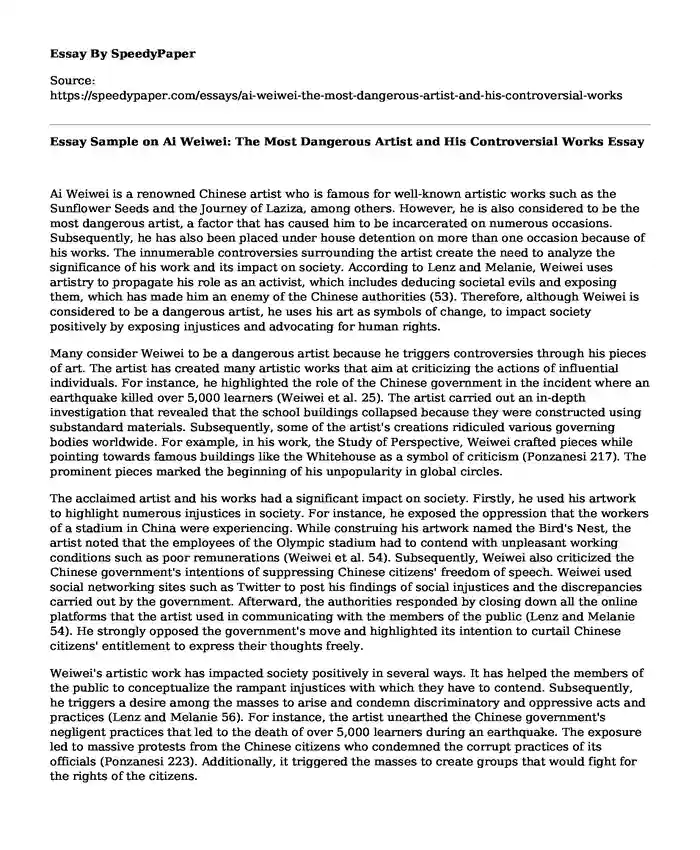Ai Weiwei is a renowned Chinese artist who is famous for well-known artistic works such as the Sunflower Seeds and the Journey of Laziza, among others. However, he is also considered to be the most dangerous artist, a factor that has caused him to be incarcerated on numerous occasions. Subsequently, he has also been placed under house detention on more than one occasion because of his works. The innumerable controversies surrounding the artist create the need to analyze the significance of his work and its impact on society. According to Lenz and Melanie, Weiwei uses artistry to propagate his role as an activist, which includes deducing societal evils and exposing them, which has made him an enemy of the Chinese authorities (53). Therefore, although Weiwei is considered to be a dangerous artist, he uses his art as symbols of change, to impact society positively by exposing injustices and advocating for human rights.
Many consider Weiwei to be a dangerous artist because he triggers controversies through his pieces of art. The artist has created many artistic works that aim at criticizing the actions of influential individuals. For instance, he highlighted the role of the Chinese government in the incident where an earthquake killed over 5,000 learners (Weiwei et al. 25). The artist carried out an in-depth investigation that revealed that the school buildings collapsed because they were constructed using substandard materials. Subsequently, some of the artist's creations ridiculed various governing bodies worldwide. For example, in his work, the Study of Perspective, Weiwei crafted pieces while pointing towards famous buildings like the Whitehouse as a symbol of criticism (Ponzanesi 217). The prominent pieces marked the beginning of his unpopularity in global circles.
The acclaimed artist and his works had a significant impact on society. Firstly, he used his artwork to highlight numerous injustices in society. For instance, he exposed the oppression that the workers of a stadium in China were experiencing. While construing his artwork named the Bird's Nest, the artist noted that the employees of the Olympic stadium had to contend with unpleasant working conditions such as poor remunerations (Weiwei et al. 54). Subsequently, Weiwei also criticized the Chinese government's intentions of suppressing Chinese citizens' freedom of speech. Weiwei used social networking sites such as Twitter to post his findings of social injustices and the discrepancies carried out by the government. Afterward, the authorities responded by closing down all the online platforms that the artist used in communicating with the members of the public (Lenz and Melanie 54). He strongly opposed the government's move and highlighted its intention to curtail Chinese citizens' entitlement to express their thoughts freely.
Weiwei's artistic work has impacted society positively in several ways. It has helped the members of the public to conceptualize the rampant injustices with which they have to contend. Subsequently, he triggers a desire among the masses to arise and condemn discriminatory and oppressive acts and practices (Lenz and Melanie 56). For instance, the artist unearthed the Chinese government's negligent practices that led to the death of over 5,000 learners during an earthquake. The exposure led to massive protests from the Chinese citizens who condemned the corrupt practices of its officials (Ponzanesi 223). Additionally, it triggered the masses to create groups that would fight for the rights of the citizens.
In conclusion, Weiwei has suffered immensely because of the assumption that he is a threat to society. He has been incarcerated on several occasions and faced other dire consequences because of his works, including harassment and house detention. However, the artist's unpopularity emanates from his desire to unearth unjust practices in society. Despite his depiction as a dangerous artist, he has impacted the community positively in many ways. Through his artistic works and actions, the citizens of China and other nations worldwide have conceptualized the need to be vigilant and expose societal evils to improve their lives.
Works Cited
Lentz, Alex, and Melanie L. Buffington. "Art+ Politics= Activism: The Work of Ai Weiwei." Art Education 73.1 (2020): 52-58.
Ponzanesi, Sandra. "The Art of Dissent: Ai Weiwei, Rebel with a Cause." (2019): 215-236.
Weiwei, Ai, et al. Ai Weiwei: Yours Truly: Art, Human Rights, and the Power of Writing a Letter. Chronicle Books, 2018.
Cite this page
Essay Sample on Ai Weiwei: The Most Dangerous Artist and His Controversial Works. (2023, Nov 30). Retrieved from https://speedypaper.com/essays/ai-weiwei-the-most-dangerous-artist-and-his-controversial-works
Request Removal
If you are the original author of this essay and no longer wish to have it published on the SpeedyPaper website, please click below to request its removal:
- Essay Sample on Multicultural Competence: FHSP Perspectives
- Sheet Music and Copyright Law - Free Essay
- Free Essay with the Analysis Report: "The Last Great Clothing Store"
- Ray - The Movie Review Essay Example
- Free Essay Example - Applied Public Relations
- Essay Example. Pandora Research Project
- Paper Example. Diversity in a Workplace
Popular categories





